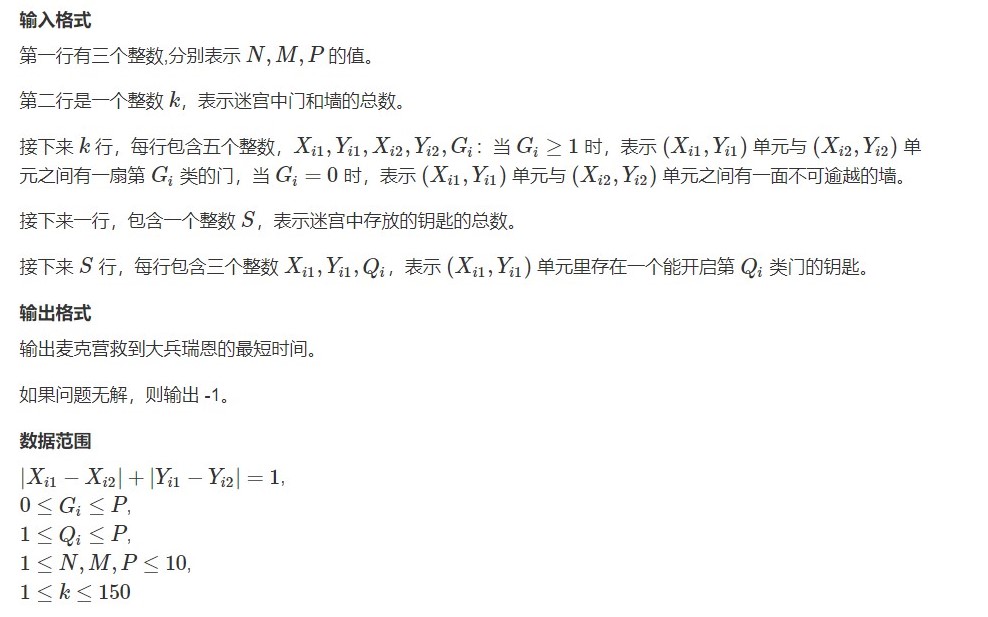孤岛营救


思路:
因为 ,所以我们需要二进制压缩一下获得的钥匙种类
用 表示从 走到 ,获得的钥匙状态是 的所有路线中的最短距离
考虑状态:
如果一个点中没有钥匙,即为
如果一个点中没有钥匙,可以选择取或者不取,即为 或者
考虑转移方程:
拿起钥匙(不需要时间):
向四周移动(花费1 ) :
因为 实际上可以看做拓扑图上的最短路问题,因此可以将其看成边权为0/1的最短路,考虑用双端 解决(或者 都可)
代码:
#include <bits/stdc++.h>
using namespace std;
typedef pair<int, int> PII;
const int N = 11, M = 360, P = 1 << 10;
int n, m, k, p;
int head[N * N], ver[M], ne[M], egde[M], tot;
int g[N][N], key[N * N];
int d[N * N][P];
bool v[N * N][P];
int dx[4] = {0, 1, 0, -1}, dy[4] = {-1, 0, 1, 0};
set<PII>e;
void add(int x, int y, int z) {
ver[++tot] = y, egde[tot] = z, ne[tot] = head[x], head[x] = tot;
}
void build () {
for (int i = 1; i <= n; i++) {
for (int j = 1; j <= m; j++) {
for (int k = 0; k < 4; k++) {
int x = i + dx[k], y = j + dy[k];
if (x < 1 || x > n || y < 1 || y > m) continue;
int a = g[i][j], b = g[x][y];
if (!e.count(make_pair(a, b))) add(a, b, 0);
}
}
}
}
int bfs () {
memset(d, 0x3f, sizeof d);
d[1][0] = 0;
deque<PII> q;
q.push_back(make_pair(1, 0));
while (q.size()) {
PII t = q.front();
q.pop_front();
int pos = t.first, s1 = t.second;
if (v[pos][s1]) continue;
v[pos][s1] = 1;
if (pos == n * m) return d[pos][s1];
if (key[pos]) {
int s2 = s1 | key[pos];
if (d[pos][s2] > d[pos][s1]) {
d[pos][s2] = d[pos][s1];
q.push_front(make_pair(pos, s2));
}
}
for (int i = head[pos]; i; i = ne[i]) {
int y = ver[i], z = egde[i];
if (!v[y][s1]) {
if (z && !(s1 >> (z - 1) & 1)) continue;
if (d[y][s1] > d[pos][s1] + 1) {
d[y][s1] = d[pos][s1] + 1;
q.push_back(make_pair(y, s1));
}
}
}
}
return -1;
}
int main () {
cin >> n >> m >> p >> k;
for (int i = 1, t = 1; i <= n; i++) {
for (int j = 1; j <= m; j++, t++) g[i][j] = t;
}
memset(head, -1, sizeof head);
while (k--) {
int x1, y1, x2, y2, c;
cin >> x1 >> y1 >> x2 >> y2 >> c;
int a = g[x1][y1], b = g[x2][y2];
e.insert(make_pair(a, b)), e.insert(make_pair(b, a));
if (c) add(a, b, c), add(b, a, c);
}
build ();
int s;
cin >> s;
while (s--) {
int x, y, c;
cin >> x >> y >> c;
key[g[x][y]] |= 1 << c - 1;
}
cout << bfs() << endl;
return 0;
}
本文作者:misasteria
本文链接:https://www.cnblogs.com/misasteria/p/16571603.html
版权声明:本作品采用知识共享署名-非商业性使用-禁止演绎 2.5 中国大陆许可协议进行许可。




【推荐】国内首个AI IDE,深度理解中文开发场景,立即下载体验Trae
【推荐】编程新体验,更懂你的AI,立即体验豆包MarsCode编程助手
【推荐】抖音旗下AI助手豆包,你的智能百科全书,全免费不限次数
【推荐】轻量又高性能的 SSH 工具 IShell:AI 加持,快人一步